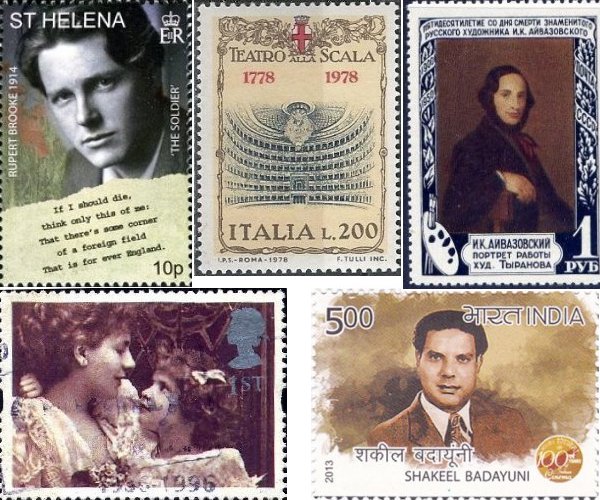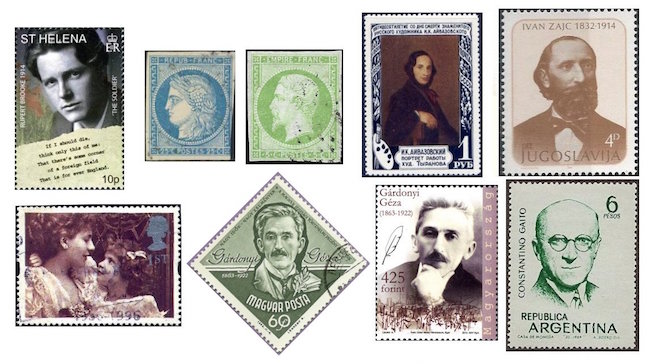The Arts on Stamps of the World — August 3
An Arts Fuse regular feature: the arts on stamps of the world.

By Doug Briscoe
I was very pleased when I discovered that somebody somewhere had seen fit to issue a stamp honoring the fine English poet Rupert Brooke (3 August 1887 – 23 April 1915). The British Overseas Territory of Saint Helena was the issuing body, and the occasion the one hundredth anniversary of his collection 1914 & Other Poems. The opening lines of one of those poems, “The Soldier”, are quoted on the stamp: “If I should die, think only this of me: / That there’s some corner of a foreign field / That is for ever England.” Brooke died from an infected mosquito bite while on board a French hospital ship moored off the Greek island of Skyros, where he is buried.
The French engraver Jean-Jacques Barre (3 August 1793 – 10 June 1855 in Paris) was responsible for the design of France’s first postage stamps in 1849: the Ceres design and the one showing the profile of Napoleon III. I show one example of each. Barre also designed bank notes, medals, and the Great Seal of France in its Second Republic version of 1848.
The Russian artist Alexey Tyranov was born at some time in 1808 and, though poor, was fortunate enough to have a brother who painted icons. The monastery where the brothers were studying happened to be visited by the prominent artist Alexey Venetsianov, who recognized Alexey’s talent, took him on as a student, and arranged for him to go to the Imperial Academy of Fine Arts. A love affair with an Italian model who robbed him of all his wealth affected Tyranov’s mind and interfered with his ability to work. Reunited, of necessity, with his brother, he died, likely of tuberculosis, on 3 August 1859. The old Soviet stamp from 1950 shows his portrait of the painter Ivan Aivazovsky, whose birthday we just recognized last week.

The Croatian composer Ivan Zajc (pron. ZEITS, August 3, 1832 – December 16, 1914) was playing piano and violin at the age of five and performed in public at six. As was so often the case, Zajc’s father opposed the idea of a career in music for his son, even though (or perhaps because) Zajc Senior was himself a military bandmaster. But he was persuaded by musical professionals and eventually relented. Zajc entered the Milan Conservatory in 1850 and won first prize with his graduation exercise, an opera called La Tirolese (1855). On his return home he took up conducting and teaching. In Vienna, where he was active from 1862 to 1870, his operas and operettas met with great success. At Zagreb he was named conductor of the Croatian Opera and director of the Croatian Institute of Music, where he made significant reforms. He was a hugely prolific composer, with his published works reaching as high a number as Op. 1202, nearly a thousand works being produced in his time in Zagreb alone. His opera Nikola Šubić Zrinjski (1876), about a 16th-century nobleman who fought the Turks, is said to be his masterpiece.
Alice Mary Hughes (3 August 1857 – 4 April 1939), the daughter of the painter Edward Robert Hughes, was a photographer who set up shop next to her father’s London studio and earned a far-reaching reputation as a portrait photographer, concentrating particularly on images of upper-crust women and children, including royalty. The UK honored her with a characteristic study on a stamp of 1995. The subjects of the 1899 photo are Alice (Mrs. George) Keppel (a longtime mistress of Edward VII) and her daughter, who grew up to be the writer Violet Trefusis, the lover of Vita Sackville-West.
Speaking of writers, we come to the Hungarian historical novelist Géza Gárdonyi (3 August 1863 – 30 October 1922), whose best known work also happens to date from around the time of the Hughes photo. He was born with the name Ziegler and worked as a teacher before beginning to write pieces for periodicals. Though he wrote in various genres, including poems and plays, he is best remembered for his novels, and the most celebrated of these is Stars of Eger (Egri csillagok, 1901, translated into English under the title Eclipse of the Crescent Moon.) Gárdonyi has been remembered on two Hungarian stamps separated by half a century (1963 and 2013).

Constantino Gaito (1878 – 14 December 1945) was a conductor, pianist, teacher, and composer who, though he studied in Naples, accentuated the local and folkloristic elements of his native Argentina in his music. Besides acting as professor of harmony and composition at the Buenos Aires Conservatory, he wrote ten operas, three ballets, an oratorio, four symphonic poems, chamber and piano music.
Ecuadorian composer, musicologist, pedagogue, and band director Segundo Luis Moreno Andrade (1882 – 18 November 1972) was director of the Conservatiories of both Cuenca and Guayaquil. His works were mostly written for military band, but there are also a Preludio Sinfónico and three Ecuadorian Suites for orchestra, a cantata, “La emancipación” (1911), written for the centenary of the independence of Venezuela, and songs. He also authored books on Ecuadorian music, including Music of the Incas (1957).
Let us turn now to two poets of India, though one wrote in Hindi and the other in Urdu. Both men were multilingual. Maithilisharan Gupt (3 August 1886 – 12 December 1964), regarded as one of the foremost Hindi poets, came from Uttar Pradesh. He was a proponent of independence and as such earned the admiration of the people. Also, he wrote in plain dialect (Khariboli) as opposed to the older literary Braj Bhasha language. Mahatma Gandhi gave him the title Rashtrakavi (National Poet) for his collection Bharat-Bharati (1912).
While Gupt knew Sanskrit, English, and Bengali, Shakeel Badayuni (3 August 1916 – 20 April 1970) studied Arabic, Urdu, Persian, and Hindi. He won a number of poetry contests while at university and in 1944 began writing song lyrics for films, working regularly with the composer Naushad Ali with great success. By the end of his career he had written music for some 90 films. One of them was Sahib Bibi Aur Ghulam (1962), which we just mentioned here the day before yesterday in connection with its star, Meena Kumari. Badayuni died from complications of diabetes at age 53.

Croatian painter Marino Tartaglia (3 August 1894 – 21 April 1984) is recognized on two stamps of the former Yugoslavia. Born in Zagreb, he studied art and architecture before decamping for Italy prior to World War I, though he did serve briefly in Salonika. In Rome he got to know Carlo Carrà and Giorgio de Chirico, returning to Zagreb in 1931 to become a teacher. The stamps, from 1969 and 1973, show his Combing (1924) and Slovenian Girl.
A name well known to fans of science fiction writing, but perhaps not so familiar to others, is Clifford D. Simak (August 3, 1904 – April 25, 1988). Like so many of his colleagues, he wrote for the pulp magazines like Astounding Stories in the 1930s; unlike them he had a lengthy career as a news editor for a major metropolitan newspaper, in his case the Minneapolis Star and Tribune. Simak won Hugo Awards for his 1959 novelette The Big Front Yard, his 1964 novel Way Station, and his 1981 short story “Grotto of the Dancing Deer”. The stamp from San Marino comes from a sheet honoring specific individual works of science fiction authors. For Simak it is his novel or interconnected series of stories City (1952), called in Italian Anni senza fine (Years without End).
Our final collage today is devoted to opera. The importance of soprano Maria Bieșu (B’YEH-shu, 1935 – May 16, 2012) to the people of her homeland can be witnessed by the three Moldovan postal issues that honor her. Besides the stamp (2012) and souvenir sheet (2007), there is the postal card on which you can see her in the costume of Cio-Cio San from Madama Butterfly. (I’ll be so indelicate as to declare that the most recent portrait is decidedly idealized.) She made her debut in 1961, performed at La Scala (see next para) from 1965 to 1967, and portrayed Nedda in her 1971 Metropolitan Opera debut, after which she had a year-long contract at the Met. She appeared as Bellini’s Norma in a 1986 Melodiya recording conducted by Mark Ermler.
One of the premier opera houses in the world, the theatre of La Scala in Milan—originally Nuovo Regio Ducale Teatro alla Scala—opened on this date in 1778. Heard on that occasion was Salieri’s opera Europa riconosciuta. The previous opera house had been destroyed by fire on 25 February 1776, and the new one was erected on the site of the church of Santa Maria alla Scala. (The church was deconsecrated and demolished.) The Teatro alla Scala underwent renovation from early 2002 to late 2004.
Deserving of mention, IMHO, are P. D. James (3 August 1920 – 27 November 2014) and Steven Millhauser (born August 3, 1943).
A graduate of the University of Massachusetts with a B.A. in English, Doug Briscoe worked in Boston classical music radio, at WCRB, WGBH, and WBUR, for about 25 years, beginning in 1977. He has the curious distinction of having succeeded Robert J. Lurtsema twice, first as host of WGBH’s weekday morning classical music program in 1993, then as host of the weekend program when Robert J.’s health failed in 2000. Doug also wrote liner notes for several of the late Gunther Schuller’s GM Recordings releases as well as program notes for the Boston Classical Orchestra. For the past few years he’s been posting a Facebook “blog” of classical music on stamps of the world, which has now been expanded to encompass all the arts for The Arts Fuse.
